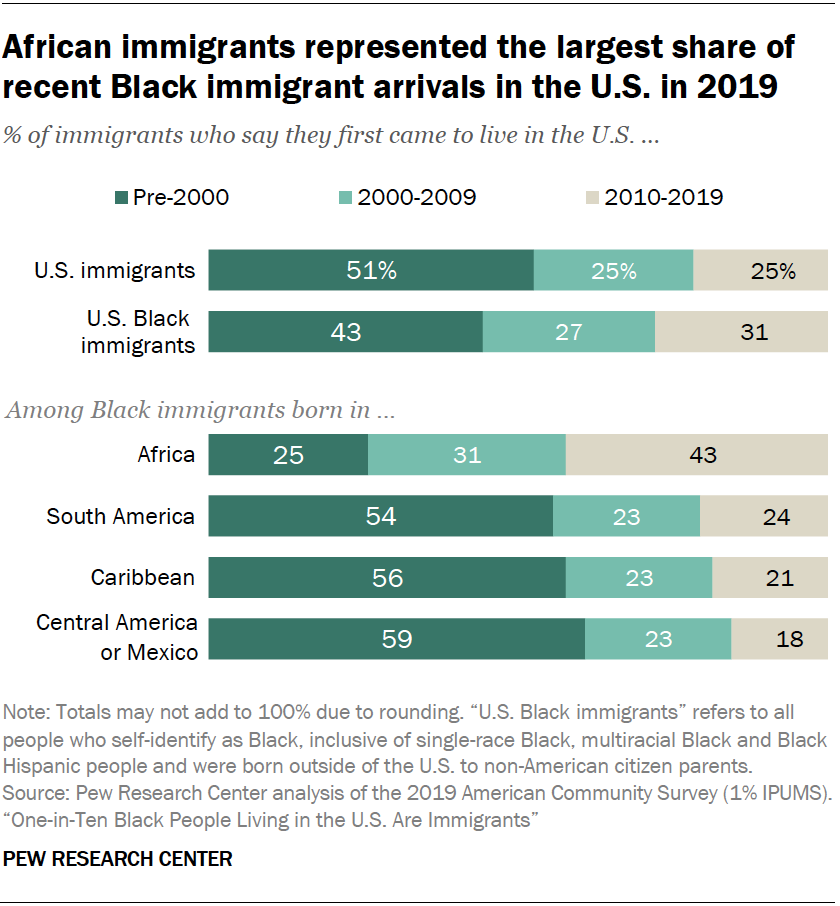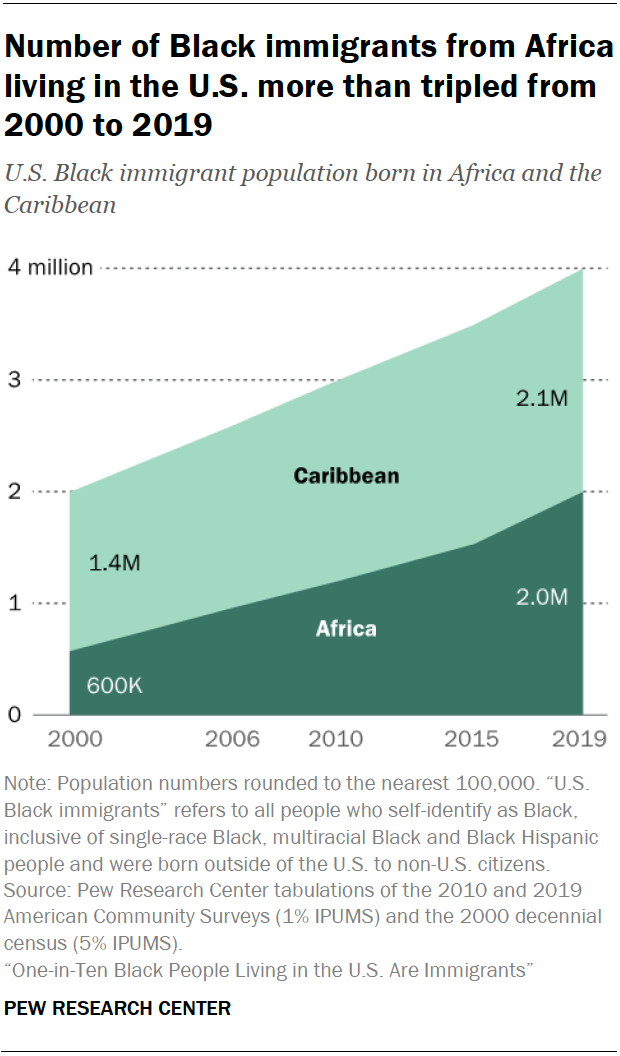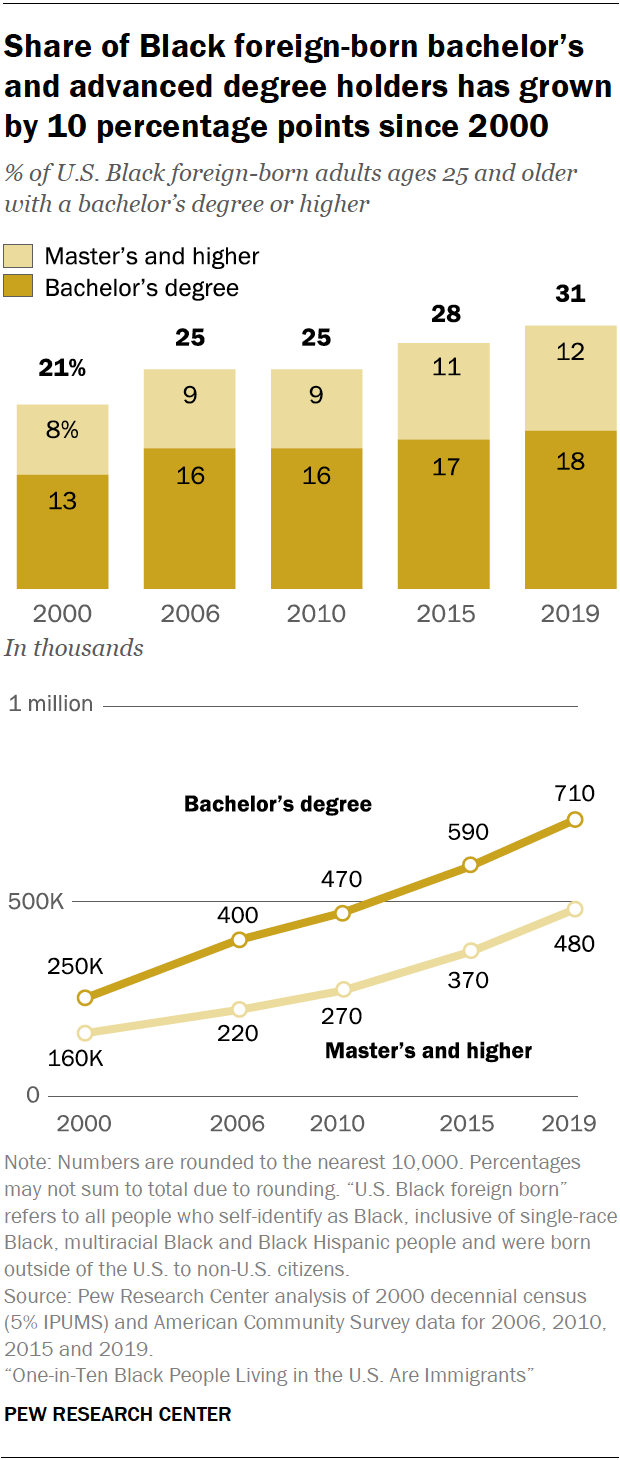Black immigrants have contributed significantly to the growth and diversity of the overall Black population in the United States. A new Pew Research Center report examines the size and characteristics of the nation’s Black immigrant population, as well as its projected growth in future years. Here are some key findings from the report.
This post highlights key findings from a larger Pew Research Center analysis of the foreign-born Black population of the United States. That study combines the latest data available from multiple data sources. It is mainly based on data from the U.S. Census Bureau’s 2006-2019 American Community Surveys (ACS) and the following U.S. decennial censuses provided through the Integrated Public Use Microdata Series (IPUMS) from the University of Minnesota: 1980 (5% sample), 1990 (5% sample) and 2000 (5% sample). U.S. Census population projections were used to estimate the size of the single-race Black foreign-born population from 2030 to 2060.
For census years 1980 and 1990, “Black immigrants” and “foreign-born Black population” refer to persons born outside the U.S., Puerto Rico or other U.S. territories whose sole self-identified race is Black, regardless of Hispanic origin. Prior to 2000, respondents to Census Bureau surveys and its decennial census could make only one selection in the race question. In 2000 and later, respondents were able to indicate they were of more than once race.
The ACS is used to present demographic characteristics for each group. Analysis about immigrant generations utilizes the March 2019 Annual Social and Economic Supplement of the Current Population Survey.
This data was collected before the COVID-19 pandemic.

One-in-ten Black people in the U.S. are immigrants. The number of Black immigrants living in the country reached 4.6 million in 2019, up from roughly 800,000 in 1980. This increase accounted for 19% of the growth in the overall Black population, which increased by 20 million during the same period. The Black immigrant population is projected to account for roughly a third of the U.S. Black population’s growth through 2060.
A sizable share of Black Americans have recent immigrant connections. In addition to the 12% of Black people who were born in a foreign country themselves, roughly 9% are second-generation Americans, meaning they were born in the U.S. and have at least one foreign-born parent. Combined, these two groups account for 21% of the overall Black population – comparable to the share among Americans overall, but lower than the share among Hispanics or Asian Americans and Pacific Islanders.

More than half of Black immigrants (58%) arrived in the U.S. after 2000. Roughly three-in-ten (31%) came to the U.S. between 2010 and 2019, and a little over a quarter (27%) immigrated between 2000 and 2009. Among all U.S. immigrants, by comparison, about half have immigrated to the country since 2o00, including a quarter who did so between 2010 and 2019 and another quarter who did so between 2000 and 2009.

Among Black immigrants, the year of immigration differs by birth region. African-born Black immigrants stand out for their more recent arrival in the U.S.: Three-quarters immigrated in 2000 or later, with over four-in-ten (43%) arriving between 2010 and 2019 alone. Black immigrants born in other regions – the Caribbean, Central America or Mexico, or South America – came to the U.S. earlier than their African-born counterparts, on average, with majorities of all three regions arriving before 2000.

Africa has accounted for the fastest growth in the U.S. Black immigrant population, but the Caribbean remains the largest origin region. Together, these two regions accounted for 88% of all Black foreign-born people in the U.S. in 2019.
Between 2000 and 2019, the Black African immigrant population grew 246%, from about 600,000 to 2.0 million. As a result, people of African origin now make up 42% of the country’s foreign-born Black population, up from just 23% in 2000.
Still, the Caribbean remains the most common region of birth for U.S. Black immigrants. Just under half of the foreign-born Black population was born in this region (46%).

Jamaica and Haiti are the top countries of origin for Black immigrants. These two countries accounted for 31% of the U.S. Black immigrant population in 2019 (16% and 15%, respectively). But their combined share was down from 39% in 2000, highlighting the growing diversity among Black immigrants. Nigeria and Ethiopia were the next most common birthplaces for Black African immigrants in 2019, with roughly 390,000 and 260,000 immigrants, respectively.
The top 10 origin countries for Black immigrants in the U.S. are all in Africa or the Caribbean. Together, these 10 nations accounted for 66% of the foreign-born Black population in 2019.

A growing share of Black immigrants have a college degree or higher. Between 2000 and 2019, the share of Black immigrants with at least a bachelor’s degree has increased faster than among other populations in this analysis. Nearly a third of Black immigrants ages 25 and older (31%) had at least a bachelor’s degree in 2019, up from 21% in 2000. This 10 percentage point increase was larger than the increase among the Black U.S.-born population (8 points), the entire U.S.-born population (9 points) and the entire immigrant population (9 points).
Overall, Black immigrants earn college degrees at a similar rate to all U.S. immigrants (31% vs. 33% among those 25 and older in 2019).
New York City has the largest Black immigrant population of any metropolitan area, numbering about 1.1 million in 2019. The Miami metro area has the second-largest such population, with roughly 490,000, followed by the Washington, D.C., area, home to roughly 260,000. The other top metro areas for Black immigrants include Atlanta, Boston, Houston and Dallas.

Some metropolitan areas have large numbers of Black immigrants from specific countries. For example, roughly 35% of the nation’s Black Jamaican immigrants live in the New York City metropolitan area. More than 35% of the nation’s Black Haitian immigrants live in the Miami area, and about 20% of the country’s Ethiopian immigrants live in the Washington area.
Regionally, the vast majority of Black immigrants lived in either the South (42%) or Northeast (36%) in 2019. The West and Midwest were each home to roughly one-tenth of this population.
Note: This is an update of a post originally published on Jan. 24, 2018.


